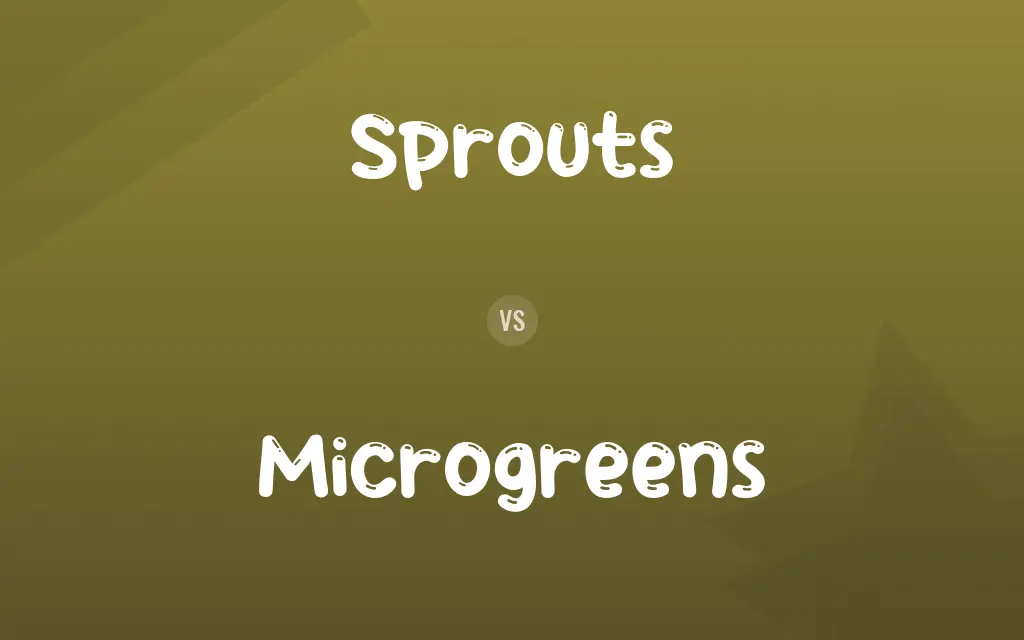Sprouts vs. Microgreens: Difference and Comparison
Edited by Muazma Batool — By Muneeza Rehman — Published on March 3, 2024
Sprouts are germinated seeds that are eaten whole, while microgreens are young vegetable greens harvested just after the cotyledon leaves have developed.

Difference Between Sprouts and Microgreens
Sprouts are produced by soaking seeds for several hours, then allowing them to germinate and grow in a moist environment for 2-7 days. This process involves eating the entire seed, including the root, stem, and undeveloped leaves. In contrast, microgreens are grown in soil or a soil substitute, require sunlight, and are harvested after the cotyledon leaves have developed, typically between 7-21 days after planting. Only the stems and leaves are consumed, not the roots.
Muneeza Rehman
Mar 03, 2024
Nutritionally, both sprouts and microgreens are packed with nutrients, but microgreens often have a higher concentration of vitamins, minerals, and antioxidants due to their more developed leaves and the photosynthesis process. Sprouts are also nutritious, offering enzymes, protein, and fiber, but there is a higher risk of bacterial contamination due to the moist germination environment.
Muneeza Rehman
Mar 03, 2024
In terms of flavor, sprouts have a milder taste compared to the intense and varied flavors of microgreens, which can range from sweet to spicy, depending on the plant variety. Microgreens are used to enhance the taste and garnish dishes, while sprouts are often added to sandwiches, salads, and wraps for both their nutritional content and texture.
Muneeza Rehman
Mar 03, 2024
From a cultivation perspective, sprouts can be easily grown at home in jars, requiring minimal space and no sunlight, making them accessible to many. Microgreens, however, while also suitable for home cultivation, require a bit more effort, including proper lighting and air circulation to thrive.
Levi
Mar 03, 2024
Both sprouts and microgreens offer a sustainable and efficient way to produce fresh greens, with a short turnaround from seed to harvest compared to mature vegetables. They can significantly contribute to a nutritious diet, providing a range of phytonutrients and flavors.
Olivia
Mar 03, 2024
Sprouts vs. Microgreens Comparison Chart
Part of Plant Eaten
Entire seed (root, stem, leaves)
Stems and leaves, roots not eaten
Muneeza Rehman
Mar 03, 2024
Growing Environment
Moist, no soil or light required
Soil or soil substitute, requires light
Muneeza Rehman
Mar 03, 2024
Nutritional Content
High in enzymes, protein, fiber
Higher concentration of vitamins, minerals, antioxidants
Muneeza Rehman
Mar 03, 2024
Risk of Contamination
Higher due to moist conditions
Lower, due to soil growth and less moisture
Kaitlyn
Mar 03, 2024
Sprouts vs. Microgreens Definitions
◉Sprouts
Moist Cultivation.
Mung bean sprouts are grown in moist conditions and are a staple in Asian cuisine.
Elijah
Feb 27, 2024
◉Microgreens
Soil-grown.
Sunflower microgreens are grown in soil, producing a nutty flavor and crunchy texture.
Muneeza Rehman
Feb 27, 2024
◉Sprouts
Germinated Seeds.
Alfalfa sprouts are germinated seeds that add a crunchy texture to salads.
Muneeza Rehman
Feb 27, 2024
◉Microgreens
Requires Light.
Basil microgreens need sufficient light to develop their distinctive aromatic flavor.
William
Feb 27, 2024
◉Sprouts
High in Enzymes.
Broccoli sprouts are known for their high enzyme content, supporting digestion.
Nolan
Feb 27, 2024
◉Microgreens
Intense Flavors.
Mustard microgreens add a peppery taste to salads and sandwiches.
Muneeza Rehman
Feb 27, 2024
◉Sprouts
Risk of Contamination.
Due to their moist growing environment, sprouts have been associated with outbreaks of foodborne illnesses.
Jonathan
Feb 27, 2024
◉Microgreens
Nutrient-rich.
Pea microgreens are packed with vitamins and antioxidants, making them a nutritious addition to any meal.
Leo
Feb 27, 2024
◉Sprouts
Mild Flavor.
Lentil sprouts offer a mild, earthy flavor to sandwiches and salads.
Muneeza Rehman
Feb 27, 2024
◉Microgreens
Young Vegetable Greens.
Radish microgreens bring a spicy flavor and vibrant color to dishes.
Muneeza Rehman
Feb 27, 2024
◉Sprouts
To emerge and develop rapidly
Businesses that sprouted along the highway.
Muneeza Rehman
Feb 26, 2024
Sprouts vs. Microgreens Frequently Asked Questions
Why are microgreens considered safer than sprouts?
Microgreens are grown in soil and less prone to bacterial contamination than sprouts, which are grown in a moist environment.
Muneeza Rehman
Mar 03, 2024
Are there any specific types of seeds that are best for sprouting or growing as microgreens?
For sprouting, alfalfa, mung bean, and broccoli seeds are popular choices. For microgreens, radish, kale, arugula, and mustard seeds are excellent for their flavor and growth characteristics.
Levi
Mar 03, 2024
How do sprouts and microgreens differ in taste?
Sprouts have a milder taste, while microgreens offer a broader range of flavors from sweet to spicy.
Nolan
Mar 03, 2024
Can sprouts and microgreens be grown at home?
Yes, both can be easily grown at home, with sprouts requiring less equipment and space.
Muneeza Rehman
Mar 03, 2024
Can you substitute sprouts for microgreens in recipes?
While they can sometimes be substituted based on texture or nutritional content, the flavor profiles may significantly differ.
Muneeza Rehman
Mar 03, 2024
Which is healthier, sprouts or microgreens?
Both are healthy, but microgreens may offer a higher concentration of certain vitamins and antioxidants.
Muneeza Rehman
Mar 03, 2024
Do sprouts and microgreens require any special fertilizers or growth mediums?
Sprouts do not require any growth medium or fertilizer, as they germinate in water. Microgreens are typically grown in soil or a soilless medium and may benefit from a mild organic fertilizer, though it's not always necessary.
William
Mar 03, 2024
How long do sprouts and microgreens last after harvesting?
Sprouts typically last about 5-7 days in the refrigerator, while microgreens can last up to 1-2 weeks when stored properly.
William
Mar 03, 2024
What are the best conditions for storing sprouts and microgreens?
Sprouts should be stored in a container that allows for air circulation and minimal moisture. Microgreens should be kept in a slightly open container to maintain freshness without drying out.
Muneeza Rehman
Mar 03, 2024
Can sprouts and microgreens be grown year-round?
Yes, both can be grown indoors year-round, provided that microgreens receive sufficient light, either from a sunny window or a grow light.
Kaitlyn
Mar 03, 2024
Content Creators
Written by
Muneeza RehmanAt Comparisons.wiki, Muneeza skillfully navigates the vast sea of information, ensuring clarity and accuracy as the lead content editor. With a keen eye for detail, she curates every comparison to enlighten and engage readers.
Edited by
Muazma BatoolAs a content editor, Muazma Batool is not just a grammar guru but a creative mastermind who breathes life into every word. With an eagle eye for detail and a passion for storytelling, she transforms bland text into engaging content that captivates audiences and drives results.

































